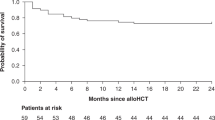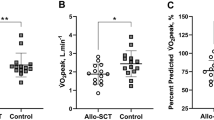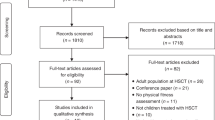Abstract
Hematopoietic cell transplantation (HCT) is a life-saving treatment for patients with high-risk hematological malignancies. Prognostic measures to determine fitness for HCT are needed to inform decision-making and interventions. VO2peak is obtained by measuring gas exchange during cycle ergometry and has not been studied as a prognostic factor in HCT. Thirty-two autologous and allogeneic HCT patients underwent VO2peak and 6 Minute Walk (6MW) testing before HCT, and provided weekly symptom and health-related quality of life (HRQOL) assessments before HCT and concluding at Day 100. Twenty-nine patients completed pre-HCT testing. Pre-HCT VO2peak was positively correlated with pre-HCT 6MW (r=0.65, P<0.001) and negatively correlated with number of chemotherapy regimens and months of chemotherapy. Patients with lower VO2peak reported higher symptom burden and inferior HRQOL at baseline and during early post-HCT period. Patients with pre-HCT VO2peak <16 mL/kg/min had higher risk of mortality post HCT (entire cohort: hazard ratio (HR) 9.1 (1.75–47.0), P=0.01; allogeneic HCT patients only: HR 6.70 (1.29–34.75), P=0.02) and more hospitalized days before Day 100 (entire cohort: median 33 vs 19, P=0.003; allogeneic HCT patients only: median 33 vs 21, P=0.004). VO2peak pre-HCT is feasible and might predict symptom severity, HRQOL and mortality. Additional studies are warranted.
This is a preview of subscription content, access via your institution
Access options
Subscribe to this journal
Receive 12 print issues and online access
$259.00 per year
only $21.58 per issue
Buy this article
- Purchase on Springer Link
- Instant access to full article PDF
Prices may be subject to local taxes which are calculated during checkout


Similar content being viewed by others
References
Pasquini MC, Wang Z . Current Use and Outcome of Hematopoietic Stem Cell Transplantation: CIBMTR Summary Slides 2011 Available at http://www.cibmtr.org.
Diaconescu R, Flowers CR, Storer B, Sorror ML, Maris MB, Maloney DG et al. Morbidity and mortality with nonmyeloablative compared with myeloablative conditioning before hematopoietic cell transplantation from HLA-matched donors. Blood 2004; 104: 1550–1558.
McClune BL, Weisdorf DJ, Pedersen TL, Tunes da Silva G, Tallman MS, Sierra J et al. Effect of age on outcome of reduced-intensity hematopoietic cell transplantation for older patients with acute myeloid leukemia in first complete remission or with myelodysplastic syndrome. J Clin Oncol 2010; 28: 1878–1887.
Andorsky DJ, Cohen M, Naeim A, Pinter-Brown L . Outcomes of auto-SCT for lymphoma in subjects aged 70 years and over. Bone Marrow Transplantation 2011; 46: 1219–1225.
Pidala J, Anasetti C, Jim H . Quality of life after allogeneic hematopoietic cell transplantation. Blood 2009; 114: 7–19.
Le RQ, Bevans M, Savani BN, Mitchell SA, Stringaris K, Koklanaris E et al. Favorable outcomes in patients surviving 5 or more years after allogeneic hematopoietic stem cell transplantation for hematologic malignancies. Biol Blood Marrow Transplant 2010; 16: 1162–1170.
Deeg HJ, Sandmaier BM . Who is fit for allogeneic transplantation? Blood 2010; 116: 4762–4770.
Armand P, Gibson CJ, Cutler C, Ho VT, Koreth J, Alyea EP et al. A disease risk index for patients undergoing allogeneic stem cell transplantation. Blood 2012; 120: 905–913.
Sorror ML, Maris MB, Storb R, Baron F, Sandmaier BM, Maloney DG et al. Hematopoietic cell transplantation (HCT)-specific comorbidity index: a new tool for risk assessment before allogeneic HCT. Blood 2005; 106: 2912–2919.
Gratwohl A . The EBMT risk score. Bone Marrow Transplant 2012; 47: 749–756.
Sorror M, Storer B, Sandmaier BM, Maloney DG, Chauncey TR, Langston A et al. Hematopoietic cell transplantation-comorbidity index and Karnofsky performance status are independent predictors of morbidity and mortality after allogeneic nonmyeloablative hematopoietic cell transplantation. Cancer 2008; 112: 1992–2001.
Jones LW, Watson D, Herndon JE 2nd, Eves ND, Haithcock BE, Loewen G et al. Peak oxygen consumption and long-term all-cause mortality in nonsmall cell lung cancer. Cancer 2010; 116: 4825–4832.
Jones LW, Courneya KS, Mackey JR, Muss HB, Pituskin EN, Scott JM et al. Cardiopulmonary function and age-related decline across the Breast Cancer Survivorship Continuum. J Clin Oncol 2012; 30: 2530–2537.
Jones LW, Hornsby WE, Goetzinger A, Forbes LM, Sherrard EL, Quist M et al. Prognostic significance of functional capacity and exercise behavior in patients with metastatic non-small cell lung cancer. Lung Cancer 2012; 76: 248–252.
Jarden M, Baadsgaard MT, Hovgaard DJ, Boesen E, Adamsen LA . randomized trial on the effect of a multimodal intervention on physical capacity, functional performance and quality of life in adult patients undergoing allogeneic SCT. Bone Marrow Transplant 2009; 43: 725–737.
Wilson RW, Jacobsen PB, Fields KK . Pilot study of a home based aerobic exercise program for sedentary cancer survivors treated with hematopoietic stem cell transplantation. Bone Marrow Transplant 2005; 35: 721–727.
Danaher EH, Ferrans C, Verlen E, Ravandi F, van Besien K, Gelms J et al. Fatigue and physical activity in patients undergoing hematopoietic stem cell transplant. Oncol Nurs Forum 2006; 33: 614–624.
DeFor TE, Burns LF, Gold EM, Weisdorf DJA . randomized trial of the effect of a walking regimen on the functional status of 100 adult allogeneic donor hematopoietic cell transplant patients. Biol Blood Marrow Transplant 2007; 13: 948–955.
Dimeo F, Fetscher S, Lange W, Mertelsmann R, Keul J . Effects of aerobic exercise on the physical performance and incidence of treatment related complications after high dose chemotherapy. Blood 1997; 90: 3390–3394.
Morris SG, Brueilly KE, Scheetz JS, de Lima MJ . Adherence of stem cell transplant recipients receiving glucocorticoid therapy to an exercise based rehabilitation program. Support Care Cancer 2012; 20: 2391–2398.
ATS Committee on proficiency Standards for Clinical Pulmonary Function Laboratories. ATS statement: guidelines for the six- minute walk test. Am J Respir Crit Care Med 2002; 166: 111–117.
American College of Sports Medicine. ACSM’s Guidelines for Exercise Testing and Prescription 8th edn. Wolters Kluwer, Lippincott Williams & Wilkins: Baltimore, MD, USA, 2009.
Hays RD, Bjorner JB, Revicki DA, Spritzer KL, Cella D . Development of physical and mental health summary scores from the patient-reported outcomes measurement information system (PROMIS) global items. Qual Life Res 2009; 18: 873–880.
Yost KJ, Eton DT, Garcia SF, Cella D . Minimally important differences were estimated for six Patient-Reported Outcomes Measurement Information System-Cancer scales in advanced-stage cancer patients. J Clin Epidemiol 2011; 64: 507–516.
Abernethy AP, Herndon JE 2nd, Wheeler JL, Patwardhan M, Shaw H, Lyerly HK et al. Improving health care efficiency and quality using tablet personal computers to collect research-quality, patient-reported data. Health Serv Res 2008; 43: 1975–1991.
Paterson DH, Cunningham DA, Koval JJ, St Croix CM . Aerobic fitness in a population of independently living men and women aged 55-86 years. Med Sci Sports Exerc 1999; 31: 1813–1820.
Knols R, de Bruin ED, Uebelhart D, Aaronson NK . The relationship between ambulatory step activity, self-reported physical functioning and standardized timed walking in patients with haematological malignancies. Disabil Rehabil 2010; 32: 1819–1826.
Studenski S, Perera S, Patel K, Rosano C, Faulkner K, Inzitari M et al. Gait speed and survival in older adults. JAMA 2011; 305: 50–58.
Boxer R, Kleppinger A, Ahmad A, Annis K, Hager D, Kenny A . The 6-minute walk is associated with frailty and predicts mortality in older adults with heart failure. Congestive Heart Failure 2010; 16: 208–213.
Brown CD, Wise RA . Field tests of exercise in COPD: the six-minute walk test and the shuttle walk test. COPD 2007; 4: 217–223.
Mitchell SA, Leidy NK, Mooney KH, Dudley WN, Beck SL, LaStayo PC et al. Determinants of functional performance in long-term survivors of allogeneic hematopoietic stem cell transplantation with chronic graft-versus-host disease (cGVHD). Bone Marrow Transplant 2010; 45: 762–769.
Morishita S, Kaida K, Ikegame K, Yoshihara S, Taniguchi K, Okada M et al. Impaired physiological function and health-related QOL in patients before hematopoietic stem-cell transplantation. Support Care Cancer 2012; 20: 821–829.
Muffly LS, Boulukos M, Swanson K, Kocherginsky M, Cerro PD, Schroeder L et al. Pilot study of comprehensive geriatric assessment (CGA) in allogeneic transplant: CGA captures a high prevalence of vulnerabilities in older transplant recipients. Biol Blood Marrow Transplant 2012; 19: 429–434.
Deschler B, Ihorst G, Platzbecker U, Germing U, Marz E, de Figuerido M et al. Parameters detected by geriatric and quality of life assessment in 195 older patients with myelodysplastic syndromes and acute myeloid leukemia are highly predictive for outcome. Haematologica 2013; 98: 208–216.
Chakraverty R, Cote D, Buchli J, Cotter P, Hsu R, Zhao G et al. An inflammatory checkpoint regulates recruitment of graft-versus-host reactive T cells to peripheral tissues. J Exp Med 2006; 203: 2021–2031.
Acknowledgements
This work was supported by the National Institutes of Health Grant KL2TR000084.
Author contributions: WW, AMD, BBR, APA, EB, SAM, CS, YHK, JW, JSS, TS and CB performed research, analyzed data and wrote the paper. All authors approved the manuscript.
Author information
Authors and Affiliations
Corresponding author
Ethics declarations
Competing interests
The authors declare no conflict of interest.
Additional information
Supplementary Information accompanies this paper on Bone Marrow Transplantation website
Supplementary information
Rights and permissions
About this article
Cite this article
Wood, W., Deal, A., Reeve, B. et al. Cardiopulmonary fitness in patients undergoing hematopoietic SCT: a pilot study. Bone Marrow Transplant 48, 1342–1349 (2013). https://doi.org/10.1038/bmt.2013.58
Received:
Revised:
Accepted:
Published:
Issue Date:
DOI: https://doi.org/10.1038/bmt.2013.58
Keywords
This article is cited by
-
Reduced cardiovascular reserve capacity in long-term allogeneic stem cell transplant survivors
Scientific Reports (2023)
-
Prehabilitative high-intensity interval training and resistance exercise in patients prior allogeneic stem cell transplantation
Scientific Reports (2023)
-
Preventing the adverse cardiovascular consequences of allogeneic stem cell transplantation with a multi-faceted exercise intervention: the ALLO-Active trial protocol
BMC Cancer (2022)
-
Inspiratory muscle training in addition to conventional physical rehabilitation in hospitalized patients undergoing hematopoietic stem cell transplantation: a randomized controlled trial
Supportive Care in Cancer (2022)
-
Cardiopulmonary performance in allogeneic hematopoietic cell transplantation recipients—evaluation of pre-transplant risk assessments
Bone Marrow Transplantation (2021)



